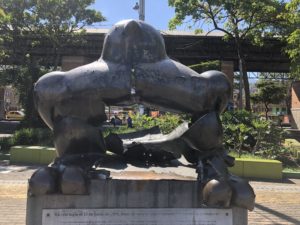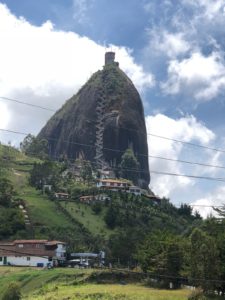
Medellin is another very big city in the mountains. Landing at the airport in Rio Negro, its a 45 minute drive over and down a huge hill providing great views of the city.

We stayed at the Hotel Park 10 (http://www.hotelpark10.com.co/en/) which provides very good value in the fashionable Poblado neighborhood. Great service, but the rooms at the hotel – which is listed as a five star property – are showing a bit of age. I did have a massage here, which was actually really good, except the treatment rooms are just inside a fifth floor balcony, separated by a curtain to the busy street below. So along with the soothing massage, the client gets serenaded by sirens, motorcycles and the other not so “tranquilo” sounds of Medellin.
Like many cities, Medellin has upscale sections, but displays some pretty intense hardship as well. Our guide Christian took us on the very modern and clean metro system to the cable car which takes you above the poverty-stricken hill-side Communas, including the notorious Communa 13 which, when controlled by groups loyal to Pablo Escobar (80s-90s), was one of the most dangerous communities in the world.

There are still many local people, however, that continue to revere the deceased drug lord. In fact, as we travelled up the cable car, a woman in her 60s saw that Christian was showing us photos of Escobar and his lieutenants and she affectionately referred to him as “Pablito” (my little Pablo).
IMHO, the biggest highlights of the Medellin city tour are the works of Colombian artist Fernando Botero. The most poignant are two bird sculptures in Parque San Antonio. In 1995, a bomb was detonated under the original bird sculpture during a concert killing 23 and wounding over 200. After the bombing, Botero created an identical sculpture and placed it along side the original bombed sculpture as a memorial to the lost lives and a reminder of Medellin’s violent past.


Other Botero highlights include the collection of twenty-three bronze sculptures in Botero Plaza which is located in Medellin’s “Old Quarter”. Christian told us that this area gets pretty seedy at night. We felt that you need to be careful even in the daytime here.

Even better is the incredible collection of Botero paintings in the Museum of Antioquia located adjacent to Botero Plaza. I normally don’t like museums but this collection is really magnificent – and contains much more that just paintings of Escobar.

The next day we visited Guatape, a resort town about an hour east of Medellin. The village itself is clean, colorful and lovely with little restaurants shops full of local handicrafts.

The main attraction, however, is the 750 step climb up El Penol.


The view is worth the climb (if you are in decent shape, and we just barely are)

and it was nice to hear the voices of a bunch of exuberant 20-ish American kids who were at the top having more than a few cold micheladas (that’s a beer with some fruit in it – very Colombian). We also took a boat ride around the reservoir below

and saw the abandoned home of one of Escobar’s daughters. If you look carefully, you can see the entrance/exit of a tunnel that could be used in case of a raid.

We ate at one particularly good restaurant here in Medellin called Carmen (http://www.carmenmedellin.com/en/). The decor is fantastic and the food amazing. As good as anything in Los Angeles. It’s located in the Poblado neighborhood – one of the very few that felt pretty safe to walk around.
We liked Medellin, but are ready to move on to Cartagena. One of our biggest issues has been a feeling of isolation. In coffee country it was virtually impossible to walk alone anywhere and in Medellin, it didn’t really feel safe. Perhaps it was safer than we thought, but looking forward to a place that is a bit more developed for touring.